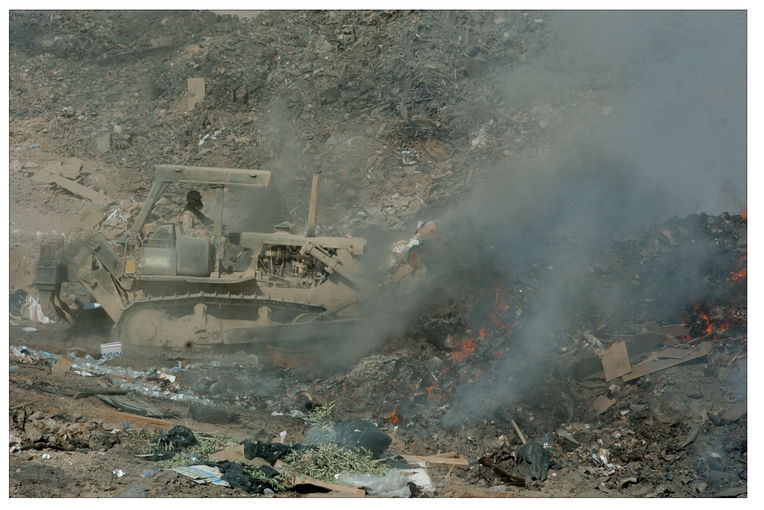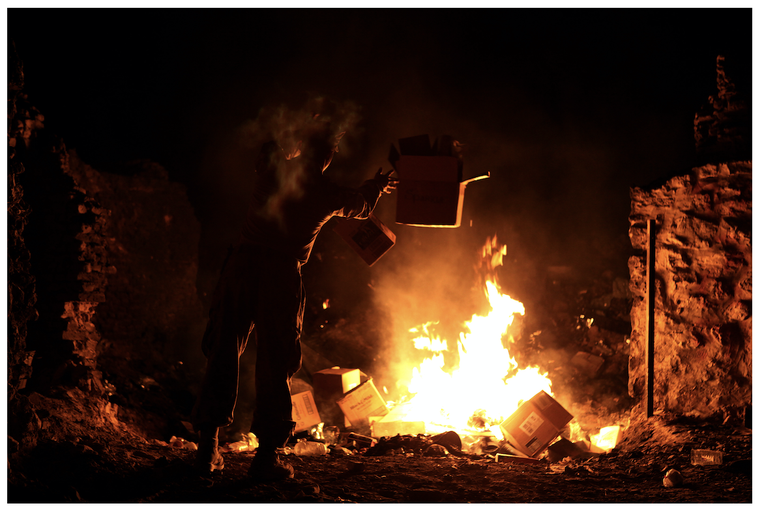Burn Pits: US Military Waste as War Violence
From the Series: Ecologies of War
From the Series: Ecologies of War

Over the past fifteen years, forward US military installations in Iraq and Afghanistan (and more recently in Syria and Egypt) produced an unprecedented volume and variety of waste: batteries, ammunition, vehicle parts, tires, e-waste, treated plywood, PVC pipe, industrial lubricants, paint, plastic water bottles, Styrofoam trays, uniforms, furniture, animal carcasses, and medical waste. Joint Base Balad in Iraq (hereafter JBB, now Balad Air Base), for instance, housed around 36,000 US and allied service members and contractors. Thanks to the US military’s commitment to semipermanent basing and subcontracted support services, JBB produced about 250 tons of waste per day, roughly three times the amount of a comparably populated town in the United States. In a perverse infrastructural loop, this waste was disposed of by dousing it in fuel and burning it in open-air pits, producing forms of toxicity unprecedented in bygone eras of US war.
Like the uncounted Iraqi and Afghan civilians who also lived downwind from the pits’ plumes, veterans and military contractors we spoke with were exposed to particulate matter and a range of irritant and pathogenic substances in the smoke. These exposures are associated with grave health problems, including soft tissue cancers, autoimmune disorders, skin conditions, asthma, and an irreversible airway disease called constrictive bronchiolitis. Waves of Iraqi and Afghan deaths and illnesses, including cancers and birth defects, have followed US invasion and occupation, associated not only with the pits but also with the United States’ use of depleted uranium munitions and other toxic materiel. This is abetted by the devastation of local infrastructures and health systems from years of US sanctions, bombing, and invasion (Dewachi 2017; Rubaii 2020).

Pollution and toxification are central to US military violence. The burn pits both exemplify and render in microcosm the way such violence fosters some privileged lifeworlds by destroying others. Of course, in a geopolitically networked world of wealthy liberal states stratified along racial and colonial lines, many people outside the US benefit from this backing and many within its own national borders do not. Highly protected and uniquely exposed, military personnel inhabit this contradiction in an especially acute way.
Veterans we talked to described disposing of fellow soldiers’ latrine waste by mixing it with barrels of burning aviation fuel, with only rags to protect them from the hazardous smoke. They told us about waking in the shipping containers they slept in drenched in sweat because their air conditioners sucked in too much airborne particulate to run. They characterized the stench, color, and quality of the smoke they inhaled and the substances they coughed up, their irreversible declines in lung capacity, and the sudden onset of terminal cancer. And they expressed a keen awareness that all of this was a direct effect of the prosaic work of making war—of soldiers eating, drinking, shitting, receiving medical treatment, wearing out their uniforms, running and repairing vehicles and computers, and doing all this potentially dirty work within spaces that had to be kept physically fortified.

The United States’ wars in Iraq and Afghanistan demanded deployments of unprecedented length and frequency for the ranks of its all-volunteer force. The solution, as Dale, a former Army medic based at Balad put it, was to “build American cities” in Iraq so that soldiers could “commute to war.” With the help of billions of dollars in for-profit contracts, ostensibly temporary bases like Balad were fitted with amenities like air-conditioned housing, regular internet access, twenty-four-hour dining facilities, gyms, and chain fast-food restaurants. In local Iraqi and Afghan infrastructures right outside the base gates, devastated by sanctions and invasion, even running water and reliable electricity were rarities.
Army guidelines for forward base construction imagine the local environment itself as exploitable, if also hostile. This right to “pollutable” land is central to colonial violence (Liboiron 2021), and indeed central to the military infrastructure by which the latter is executed. In this case, though, security protocols demand waste not be allowed to “endanger” local civilians, become weaponized by enemies, or require soldiers to risk their safety while disposing of it. At the same time, waste cannot be allowed to accumulate inside a base. In an inversion of what Sophia Stamatopoulou-Robbins (2019) calls “waste siege” imposed from the outside, base waste is unexternalizable. So it is burned in fires accelerated by JP-8, a kerosene-based fuel used in nearly all US and NATO military aircraft and vehicles. The same relatively low combustion temperature that makes JP-8 useful for burning trash and human waste also contributes to the generation of fine particles and hazardous organic compounds in the smoke. Even as the military assumes a prerogative to pollute, soldiers and their waste can never get very far from one another.
Burn pits exemplify the “deadly” logistical systems of empire (Cowen 2014) that merge slow violence with fast. They show how the uneven distribution of toxic harm is built into the practices and policies that sustain US military force. This is not collateral damage or accident but an infrastructural violence all its own, one with global implications: the US military’s carbon footprint outstrips that of many small, industrialized nations, and there is no being on earth not in some way downwind of its effects. Through the smoke of the pits, we glimpse the violence of military biopolitics, which produces harm in the name of making life and sustains life in the service of killing and killability. Though the use of burn pits has declined, especially following the withdrawal of the bulk of US forces from both Iraq and Afghanistan, the pits’ logics and logistics remain embedded in US military doctrine, and the slow burn of their transformative toxicity goes on.
Cowen, Deborah. 2014. The Deadly Life of Logistics: Mapping Violence in Global Trade. Minneapolis, MN: University of Minnesota Press.
Dewachi, Omar. 2017. Ungovernable Life: Mandatory Medicine and Statecraft in Iraq. Stanford, CA: Stanford University Press.
Liboiron, Max. 2021. Pollution Is Colonialism. Durham, NC: Duke University Press.
Rubaii, Kali. 2020. “Birth Defects and the Toxic Legacy of War in Iraq.” Middle East Research and Information Project. September 22, 2020.
Stamatopoulou-Robbins, Sophia. 2019. Waste Siege: The Life of Infrastructure in Palestine. Stanford, CA: Stanford University Press.